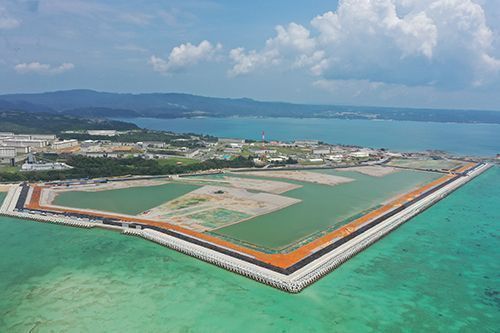OPG loses Henoko coral lawsuit with two of five judges holding a dissenting opinion

The site of FRF construction where land reclamation and seawall construction are advancing, photographed on the morning of September 3, 2020 on the coast on Camp Schwab in Henoko, Nago City (photograph taken by drone)
July 7, 2021 Ryukyu Shimpo
On July 6 the Third Petty Bench of the Supreme Court (Presiding Judge Michiharu Hayashi) dismissed the final appeal of the Henoko coral lawsuit filed by the Okinawa Prefectural Government (OPG). The lawsuit was in response to the Minister of Agriculture, Forestry and Fisheries issuing a directive telling the OPG to authorize the special collection (transplantation) of coral by the Okinawa Defense Bureau (ODB) for the sake of the transplantation of some varieties of coral in Oura Bay due to the construction of the Futenma Replacement Facility (FRF) in Henoko, Nago City. In the lawsuit, the OPG requested that the directive be declared illegal and revoked. The Third Petty Bench upheld the ruling by the Naha Branch of the Fukuoka High Court that the Minister’s directive is legal, confirming the OPG’s loss of the case. Two of the five judges dissented.
In a press conference after the ruling, Governor Denny Tamaki said, “Although the final appeal ended in dismissal, an unprecedented dissenting opinion was held, accepting the OPG’s claim.”
In 2019, the ODB petitioned for authorization from the OPG to transplant approximately 400,000 coral colonies. When it became clear that there is soft seafloor in the site planned for land reclamation, the OPG held off on making a decision. In February last year, the Agriculture Minister directed the OPG to authorize transplantation as petitioned by the ODB, as requested. The OPG requested that the third-party organization Committee for Settling National-Local Disputes investigate, but the request was turned down, and the OPG presented its case to the Naha Branch of the Fukuoka High Court in July last year.
When the soft seafloor issue arose, the OPG had an opportunity to petition for changes to the outline of the plan and asserted that it is uncertain whether land reclamation will be completed. Although the Third Petty Bench was not able to decide whether transplantation should be authorized, it did decide that there are sites outside the areas of the soft seafloor where the ODB can carry out seawall construction. Given the concern that the coral will go extinct due to construction, the Third Petty Bench decided that transplantation is necessary to protect the coral.
The decision acknowledged that the OPG’s request could result in effectively stopping seawall construction thereby encroaching on the ODB’s position, and is a deviation from or misuse of discretionary power.
The dissenting opinion was held by Judge Katsuya Uga, whose background is in administrative law, and Judge Yuko Miyazaki, whose background is as an attorney. The opinion pointed out that seawall construction will be meaningless if the petition to change the outline of the plan is not approved while the coral, to which the petition pertains, exists outside the areas of soft seafloor. The dissenting opinion also concluded that it was not illegal for the OPG to have not authorized the transplantation, because as long as changes are not petitioned, it would not be possible to attain sufficient information about whether transplantation of coral should be authorized.
(English translation by T&CT and Erin Jones)

On the evening of July 6 at the Prefectural Office, Governor Denny Tamaki answers reporters’ questions after the Supreme Court handed down its decision against the OPG in the Henoko coral lawsuit (photograph taken by John Matsumoto)
Previous Article:Naha District Court accepts 12 base employees’ claims of baseless punishment and unjust treatment
Next Article:On Tanabata night, sparkling Milky Way observable by naked eye in Okinawa
[Similar Articles]
- National government starts coral transplantation, ignores authorization conditions from OPG
- [Editorial]The Supreme Court’s decision on Takae lawsuit is unjustifiable
- OPG loses lawsuit against Land Minister’s decision to cancel OPG’s revocation of land reclamation permission
- Digital Edition Extra: Supreme Court dismisses Okinawa’s appeal in Henoko lawsuit
- Dugong lawsuit appealed to U.S. High Court
 Webcam(Kokusai Street)
Webcam(Kokusai Street)


